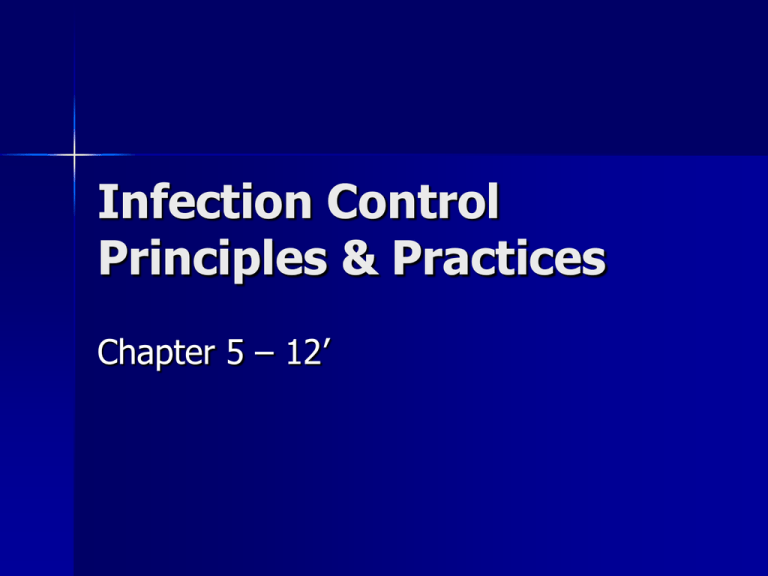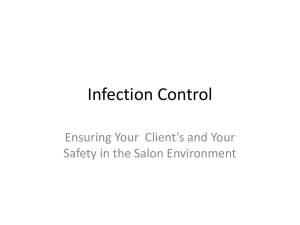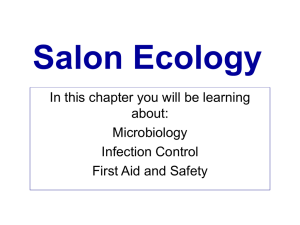
Infection Control
Principles & Practices
Chapter 5 – 12’
It
is your duty to ensure
that your clients receive
their services in the
safest possible
environment
Why Study This?
To be a knowledgeable, successful and
responsible professional you are
required to understand the types of
infections you may encounter.
Understanding the basics of cleaning
and disinfecting and following state
rules will ensure a long successful
career.
Understanding the chemistry of the
cleaning and disinfecting products you
use and how to use them will keep
you, your clients, and the salon
environment safe.
Regulation
Federal agencies set guidelines for
– Manufacturing
– Sale
– Use of equipment
– Chemical ingredients
– Monitor Safety in the workplace
– Place limits on types of services
performed
Occupational Safety and
Health Administration
(OSHA)
Created b y the US Department of
Labor
– Occupational Safety and Health
Administration - OSHA HOME PAGE
Regulate and enforce safety and
health standards in the workplace
Occupational Safety and
Health Act of 1970
Regulating employee exposure to toxic
substances
Informing about the dangers of
materials used
Hazard Communication Rule
Requires chemical mfg. and importers
assess the hazards associated with
their products
MSDS and product labeling are
important results of this law
Products in salons
Standards address:
– Handling
– Mixing
– Storing
– disposing
General safety in the workforce
Your right to know the hazardous
ingredients in the products you use
Material Safety Data
Sheet (MSDS)
Federal law requires manufactures
(mfg.) to provide
Contains important information about
chemicals
– Hazardous ingredients
– Safe use and handling procedures
– Safety precautions to reduce the risk of
harm and overexposure
– Associated hazards
– Combustion levels (flammability and data
in case of fire)
– Disposal guidelines – EPA fines
– Medical information
– Storage requirements etc.
– Ingredients
OSHA and state regulatory agencies
require MSDSs be kept available
State Inspectors can issue fines for not
having MSDSs available
Material Safety Data Sheet
Not having an MSDS
Poses a health risk to all exposed to
hazardous materials
Is a violation of federal regulations
Take time to read all of the
information to be certain that you
are protecting yourself and your
clients to the best of your ability
Environmental Protection
Agency (EPA)
Two types of disinfectants used in
salons
1. Hospital - products are safe for
cleaning blood and body fluids
2. Tuberculocidal – proven to kill the
bacteria that causes tuberculosis
It is against FEDERAL LAW to use any
disinfecting product contrary to its
labeling
If you do not follow the instructions
for mixing, contact time and the type
of surface the disinfecting product can
be used on, you have broken a federal
Law.
State Regulatory
Agencies
Exist to protect the consumer’s health,
safety, and welfare while receiving
services
Everyone working in a salon/spa must
follow specific procedures
Enforcement through inspections and
investigations of consumer complaints
Issue penalties against both the salon
and the operator (designer/technician)
– Warnings to fines
– Probation
– Suspension or revocation of licenses
– Jail time
Laws/Rules – What is the
difference?
Laws are written by legislature
– Determine the scope of practice (what
each license is allowed to do)
– Establish guidelines for regulatory
agencies to make rules
Laws/statutes
Rules/Regulations are written by the
regulatory agency or board
– Determines how the law will be applied
Rules establish specific standards of
conduct, can be changed and updated
FYI Pp. 72
Principles of Infection
One careless
action could
cause injury or
infection
(write in side notes)
We are not seeking to treat any
disease or conditions
We are taking steps so that the tools
and equipment we use are safe to use
on clients
Infection Control
Methods used to eliminate or reduce
the transmission of infectious
organisms
4 types of potentially harmful
organisms
– Bacteria
– Viruses
- Fungi
- Parasites
Infectious disease –caused by
pathogenic organisms that enter the
body
Clean – mechanical process using soap
and water or detergent and water to
remove all visible dirt, debris and
germs from tools, implements and
equipment
Disinfection – destroys most harmful
organisms on environmental surfaces
Disinfectants
Bactericidal – kills bacteria
Virucidal – kills virus
Fungicidal – kills fungus
Dirty salon tools and equipment may
spread infection from client to client.
You have an OBLIGATION to provide
safe services and prevent consumers
from harm
You may be found
legally responsible
for not correctly
performing
services!
Bacteria
Minute one-celled organisms
Known as germs or microbes (write in)
Can exist almost everywhere
Can be only seen with aid of a
microscope
1,500 rod-shaped will fit on the head
of a pin (write in)
Types of Bacteria
Nonpathogenic
– Helpful or harmless; not disease
producing
– Help metabolize food
– Protect against infectious
microorganisms
– Stimulate immune response
– Saprophytes – lives on dead matter
Pathogenic
– Harmful; disease producing
– Parasites – require living matter for
their growth
Classifications of
Pathogenic Bacteria
Cocci – round shape, appear singly or
alone
– Staphylococci – pus-forming, grow in
bunches/clusters (like grapes), cause
boils, abscesses and pustules
Streptococci – pus-forming, arranged
in curved lines (like a string of beads),
strep throat, blood poisoning
Diplococci – grow in pairs , cause
pneumonia
Bacilli – short, rod-shaped, most
common, cause tetanus and
tuberculosis
Spirilla – spiral, corkscrew shaped,
cause Lyme disease
Movement of Bacteria
Motility – self movement
Cocci –
– transmitted in the air, in dust or within
the substance in which they settle
Bacilli and Spirilla – motile –
– use slender hairlike extensions called
flagella or cilia
– Whip like motion propels bacteria through
liquid
Important Tables in Book
Table 5-1 Definitions relating to causes
of disease – pp. 75
Table 5-2 General terms relating to
disease – pp. 78
Bacterial Growth and
Reproduction
Bacteria
– Manufacture their own food from the
surrounding environment
– Give off waste
– Grow and reproduce
Protoplasm – outer cell wall containing
liquid
Active Stage
Warm, dark, damp or dirty places
where food is available
Mitosis/Binary Fission
– Bacteria reach largest size - divide
into two (2) new cells
– Daughter cells
Unfavorable conditions they die or
become inactive
Mitosis: An Interactive Animation
Mitosis
Mitosis
Inactive or Spore –
Forming Stage
Spherical spores with tough waxy
outer coverings/shells
Withstand periods of famine,
dryness, and unsuitable
temperatures
Can be blown about and not
harmed by disinfectants, heat or
cold
Spores are dangerous if they enter the
body
Pose little to no risk to clients in the
salon
Bacterial Infections
Inflammation – the body reacts to
injury, irritation, or infection
Inflammation is characterized
– Redness
– Heat
– Pain
– swelling
Infection – occurs when body tissues
are invaded by pathogenic bacteria
Pus – is a fluid product of
inflammation and contains white blood
cells, dead cells, and bacteria
The presence of pus is a sign of
infection
Local Infection – is one confined to a
particular part of the body and is
indicated by a lesion containing pus
General Infection – results when the
bloodstream carries the bacteria or
virus and their toxins to all parts of the
body
Staphylococci
Among the most common human
bacteria and carried by 1/3 of the
population
Picked up –
– Doorknobs, countertops, other
surfaces
– Skin to skin contact – shaking
hands, unclean implements
Some Staph infections are now
resistant to antibiotics
– Symptoms – skin infections, pimples and
boils
Greatest need for proper infection
control measures
Methicillin-resistant
staphylococcus aureus
MRSA
– Weakened immune system
– Medical procedures
Appears as skin infection that can be
difficult to cure
You owe it to yourself and your clients
to clean and disinfect tools,
implements and equipment
Do not perform any service if signs of
abrasions or infection!
Contagious – communicable – a
disease spread from one person to
another by contact
Spread most commonly by
– Dirty hands – especially under fingernails
or webs between fingers
Chief Sources of
contagion
Unclean hands and implements
Open sores, pus, mouth and nose
discharges
Shared drinking cups and towels
Telephone receivers
Uncovered coughing or sneezing and
spitting in public
Infected nails
Viruses
Parasitic submicroscopic particle that
infects and resides in the cells of a
biological organism.
Capable of infecting almost all plants
and animals, including bacteria
Seen only with the most sophisticated
and powerful microscopes
Cause
Common colds and other respiratory
and gastrointestinal infections
Measles, mumps, chicken pox,
smallpox, rabies, yellow fever,
hepatitis, polio, influenza, and HIV
Differences
Virus – can live and reproduce only by
penetrating other cells and becoming
part of them
Bacteria – can live and reproduce on
their own
Antibiotics
– Bacteria – treated
– Viruses – not affected by
Vaccination can prevent viruses from
growing in the body
Bloodborne Pathogens
Disease causing bacteria that are
transmitted through the body in the
blood or body fluids
Use great care to avoid damaging the
client’s skin during any type of service
Spread anytime skin is
broken
Hair cutting
Shaving
Nipping
Clipping
Facial treatments
Waxing/tweezing
Chemical burns
Federal law - Cutting skin is allowed
by qualified medical professionals
Cutting hardened cuticle and removing
callus are both considered medical
procedures
Hepatitis
Blood borne pathogen that damages
the liver
Easier to contract than HIV
Present in all body fluids of infected
person
Can live on a surface outside the body
for a long time
Vital all surfaces are thoroughly
cleaned
Be sure to clean hands after coughing
or sneezing
Types
A, B, C
Hepatitis B – most difficult to kill on a
surface – check label of disinfectant
Public workers should be vaccinated
HIV/AIDS
Human Immunodeficiency Virus
Acquired Immune Deficiency
Syndrome
Breaks down the body’s immune
system
Person to person through blood and
other body fluids
Infected many years without
symptoms
Testing can tell if infected within 6
months of exposure
Spread
Needles – intravenous drug users
Unprotected sexual contact
Accidents with needles in the
healthcare field
Less likely to enter the bloodstream
through cuts and sores
Not Spread
Holding hands
Hugging
Kissing
Sharing food or household items
Currently no documented cases of
food handlers, insects, or casual
contact or hair, skin, or nail services
How Pathogens Enter the
Body
FYI page 81:
Enter the body:
– Break in the skin
– Mouth
– Nose
– Eyes and ears
– Unprotected sex
Body Fights Infection
Unbroken skin
Body secretions
White cells
antitoxins
Human Disease Carrier
A person who is personally immune to
a disease, yet can transmit germs to
other people
(write in on PP 81)
Fungi
Vegetable (plant) parasites
– Molds
– Mildews
– Yeasts
– Produce contagious diseases
Ringworm
Areas affected
Tinea Barbae – barber’s itch –
superficial fungal infection Mustache/beard
Around neck or scalp
– Usually older adolescents and adult men
Tinea Capitis – fungal infection on the
scalp
Cleaning clippers of all visible hair
Disinfecting properly reduces the risk
of spreading skin and scalp infections
Using compressed air to clean clipper
blades – effective and saves time
Nail Fungus
Implements not properly disinfected
Not properly preparing surface of the
natural nail before enhancement
products are applied
Moisture trapped under nail
enhancements
Chronic and localized 1 or 2 fingers or
toes
Can be spread to other nails and
clients if implements are not
disinfected before and after each client
FDA determined topical treatment
applied directly to the affected area is
NOT effective
FDA prohibits sale of antifungal
products for finger or toenails without
a medical prescription
Refer to a physician
Parasites
Vegetable or animal organisms that
live on another living organism and
draw their nourishment from that
organism
Animal Parasites
Pediculosis Capitis
– Head lice
Scabies
– Itch mite – burrows under the skin
Both extremely contagious
NEVER treated or work on in a salon!!!
Refer to a physician
Clean contaminated areas with
pesticide or insecticide – mfg.
directions
Parasites
Vegetable
Animal
Immunity
The ability of the body to destroy any
bacteria that have gained entrance
and resist infection in general
Natural immunity
– Partly inherited
– Partly developed through hygienic living
Acquired immunity
– The body develops after it
overcomes a disease
– Through inoculation (chicken Pox)
Principles of Prevention
Proper care must be taken to meet
rigorous health standards
Controlling infection and disease is a
vitally important aspect of the salon
industry
You must ensure the safety of your
clients
Three main levels
(write on page 82)
– 1st – sterilization
– 2nd – disinfection
– 3rd - sanitation
Only disinfection and sanitation are
required in a salon
Proper decontamination can prevent
spread of disease caused by infectious
material on a surface
Prevent exposure to blood and visible
debris or residue
Decontamination
Contaminants – substances that can
cause contamination (write on PP 82)
– Hair in a comb, makeup on a towel, nail
dust on a file
A salon can never be completely free
from all contamination
It is YOUR responsibility as a
professional to be constantly looking
for disease causing contaminants
Decontamination
The removal of blood or other
potentially infectious materials on an
item’s surface and the removal of
visible debris or residue
Disinfection
Second level
Kills most microorganisms on hard
nonporous surfaces
Decontamination Method 1
2 steps
– Cleaning
– Disinfecting
Step 1:Cleaning:
– Remove all visible dirt & debris
– Wash with warm water & soap
– Scrub with brush grooves and crevices
Surface is cleaned when number of
contaminates is greatly reduced
A surface must be properly cleaned
before it can be disinfected
Properly clean and sanitize hands
– Discussed later in chapter
3 ways to clean
tools/implements
Wash with soap and water
– Scrub with brush
Ultrasonic unit
Cleaning solvent
Step 2: Disinfection
– Eliminates most microorganisms
– Not effective against bacterial spores
Disinfectant label must have:
– EPA registration number
– Specific organisms the solution is
effective in killing
– Use according to MFG directions!!!!!!!!!!!!
Disinfectants are not for use on
human skin, hair or nails!
Never use as hand cleaners!
Read carefully before using!
Disinfectants can be dangerous if used
improperly
Must be approved by the
Environmental Protection Agency
(EPA) and each individual state
All disinfectants clearly state on the
label to avoid skin contact
Do not put your fingers directly into
any disinfectant solution
These are pesticides
All bottles must be labeled!
Caution boxes on page 84
Decontamination Method 2
2 steps:
– Cleaning
– Sterilization
Sterilization
Highest level
Completely destroys all microbial life
on a surface
Kills bacterial spores (inactive stage) –
most resistant form of life
Dentist and surgeons use
Methods –
– high-pressure steam
– dry heat autoclave
Less effective, require longer times at higher
temperatures
– chemicals
Texas – manicurists
Autoclaves
Pressurized
Steam penetrates spore coats of
pathogens
Require regular maintenance and
testing
Color strips on bags are indicators not
verifiers
CDC requires autoclaves to be tested
weekly
– Spore test
– Send to contracted lab
– Find on internet
If intended temps are not reached –
creates a breeding ground for
pathogens (warm, moist, dark)
Follow mfg. directions!!!!!!!!!!!!!!!
– Cleaning
– changing water
– Service visits
– Replacement parts
– Required maintenance
Keep a logbook
Cannot sterilize the skin or nail plate
without killing it
If estheticians use needles and probes
that lance the skin - they must also
use sterilization processes
Best to use disposable
Only non porous surface can be
sterilized
Metal implements can be sterilized but
wood cannot
Sterilization in a salon is impractical
and unnecessary
Unless exposed to blood
Choosing a Disinfectant
Read the label! to use properly and
safely
Follow mfg. directions!
Mixing precautions
Exposure times
What the disinfectant has been tested
for
Disinfectants
Chemical agents used to destroy most
– bacteria
– Fungi
– Some viruses and to disinfect
implements and surfaces
Does not kill bacterial spores
Mixing chemicals stronger than
recommended by the manufacturer
counteracts their effectiveness
The use of goggles and gloves is
usually recommended
Mixing ratios are & contact time are
VERY important
If concentrate is NOT on the label it is
ready to use without mixing
Contact time – amount of time the
surface must stay moist with
disinfectant to be effective
Efficacy
The ability to produce an effect
Effectiveness with which solution will
kill organisms
To meet salon requirements
– Bacteria
– Fungi
– viruses
Ideal disinfectant
See list page 85
“Did you Know” box - pp.. 85
Caution box - pp.. 85
When salon implements come into
contact blood, body fluids or unhealthy
conditions:
– Cleansed
– Completely immersed in an EPARegistered hospital disinfectant solution
– Effective against HIV, hepatitis,
tuberculosis
– 10% bleach solution
Always wear gloves
Follow Universal Precautions
Proper Use of
Disinfectants
Any item that is used on a client must
be disinfected or discarded
All implements must be thoroughly
cleansed before soaking to avoid
contaminating the disinfection solution
“Did you Know” box – pp.. 86
Implements be completely submerged
for proper disinfection
Complete immersion – cover all
surfaces of the item
Disinfectant Tips:
Pre-cleaned, hard, non-porous
surfaces
Wear gloves and safety glasses
Dilute according to mfg. directions
Immerse and soak according to the
label
Spray and leave on for required mfg.
time on label
If directions say to immerse – spraying
will not work
Change solution according to mfg.
directions
Circulate in whirlpool spas for required
mfg. time
Any other use than that on the label is
a violation of Federal Law (write on page
86)
NOTE: absorbent nail files must be
thrown out if break client’s skin or
make contact with unhealthy skin or
nails
– Ex: nail with a fungus
– Ex. infected hangnail
Types of Disinfectants
QUATS – Quaternary Ammonium
Compounds
– Considered non-toxic, odorless and fastacting
– Immerse implements for 10 minutes
– Enough liquid to cover all surfaces of item
– Contain anti-rust ingredients
– Leaving tools in solution too long can
cause damage
– Remove, rinse, dried, stored in clean
covered container
– Metal implements should be oiled
regularly
– Effective for countertops and tables
Phenols
– Form of formaldehyde
– Caustic poison – high pH
– Can cause damage to skin and eyes, and
some environments
– Can be safe and effective if used
according to instructions
– Harmful to environment of put down
drain
– Disadvantage – most rubber and plastic
materials may be softened or discolored
– Metal implements can rust
– Extra care to avoid skin contact – cause
irritation
– concentrated formulas can seriously burn
the skin and burn the eyes
– Some are poisonous if accidentally
ingested
– carcinogens
Alcohol and Bleach
– Ethanol (70%) and Isopropyl (99%)
alcohol are used sometimes to disinfect
metal implements
– Alcohol is NOT an EPA registered
disinfectant – therefore not permitted for
use on implements in states where
hospital level disinfectants are required
– Disadvantages:
Extremely flammable, evaporate
quickly, slow-acting, less effective
Corrode implements and cause sharp
edges to become dull
They discolor and damage the surface
of floors and countertops
Vapors can cause headaches and
nausea when inhaled in high
concentrations or after prolong
exposure
Bleach
– Sodium Hypochlorite
– Household bleach
– Effective disinfectant
– Some of the same disadvantages as
alcohol
– Not for use in most states
– Effective additive for laundry
Follow mfg. directions
Store solution away from heat & light
Mix every 24 hours
Can irritating to lungs
Do not inhale fumes
Commercial cleansers
– Lysol and pine-sol
– Floors, bathrooms, sinks, waste cans
– Not for use on salon implements
– General household cleaners
– Not for professional tools
Fumigants –
Caution box pp.. 87
Formalin tablets – before EPA
Formaldehyde vapors cause cancer
Allergic sensitivity for those who
constantly breathe vapors
Kills one fungus in 24 hours
Vapors are poisonous
Irritating to eyes, nose, throat, lungs
Glutaraldehyde
Dangerous chemical used to sterilize
surgical instruments in hospitals
Not safe for salon use
Pseudomonacidal
Formulated for hospitals and health
care facilities
Hospital disinfectant
PP 86/87 –
– Bactericidal
– Fungicidal
– Virucidal
Tuberculocidal
EPA registered effective against HIV or
HPV
Meet OSHA’s Bloodborne Pathogens
Standards
– Write on page 87
Ultrasonic cleansers use highfrequency sound waves to create
powerful cleansing bubbles in the
liquid (write pp. 86)
– Reaches tiny crevices
– Useful addition to your disinfection
process, but not required
– Saves time by eliminating cleaning by
hand
Disinfectant Safety
Pesticides - poison
Can be hazardous if used incorrectly
Poisonous if ingested
Can cause serious skin and eye
damage
USE CAUTION!
Follow mfg. directions
List on pp. 88
Wet disinfectant jars – solutions
changed daily – wear gloves
kept free from debris
Purpose is to disinfect – not clean
Covered but not airtight
Follow mfg. directions
Disinfect or Dispose
Multi-use
– Cleaned
– Disinfected
– Used more than once
“Disinfectable”
– Items that can be disinfected
Multiuse:
– Reusable
– Cleaned & disinfected
– Used on more than 1 person
– Hard, nonporous surface
Single-use:
– Disposable
– Cannot be used more than 1 time
– Cannot properly be cleaned
– Thrown out after each use
Porous
– Made or constructed of an absorbent
material (has open pores or openings)
Contact with broken skin, blood, body
fluids, or any unhealthy conditions
MUST BE DISCARDED!!!!!!!!!!!!
Caution boxes pp. 89
Keep a logbook
– Follow mfg. directions
– State may not require
– Clients peace of mind & confidence in you
Disinfecting nonelectrical
tools & equipment
Multiuse tools & implements must be
cleaned & disinfected before & after
every service
Mix according to mfg. directions!
Remember to always add the
disinfectant to the water
Pp. 96
Disinfecting Implements
Pre-clean
2. Rinse thoroughly and pat dry
3. gloves, goggles or safety glasses
4. Mix disinfectant according to mfg.
directions
5. Use gloves or tongs, completely
immerse implements or tools – soak
for the required time
6. Remove from solution with tongs,
basket, or gloves
7. Rinse thoroughly, and dry
8. Place disinfected implements in clean,
dry, disinfected container
(pictures PP 96)
Disinfecting Electrical
Tools/Equipment
Contact points cannot be immersed in
a wet solution
Spray with EPA registered, hospitalgrade disinfectant for electrical
equipment
Follow mfg. directions
Disinfecting Work
Surfaces
Before and after each client spray with
hospital-grade disinfectant
Any surface client’s skin came into
contact
Doorknobs, phones etc. - transferring
germs
Follow mfg. directions
– Usually 10 minutes
Disinfection Procedures
Clean surface
2. Spray disinfectant
3. Let stand 10 minutes
4. Wipe dry
(write on top/bottom of page 90 or
91)
Disinfecting Linens, Capes
and Towels
Laundered and bleached according to
label directions
Completely dried
All capes and linens that come into
contact with clients must be laundered
according to mfg. directions
Use Sanex strips
Store soiled linens in covered close
container
Use disposable towels as much as
possible (bathrooms)
Do not allow capes to touch client’s
skin
Wash after each client
Disinfecting Pedicure
Equipment & Foot Spas
Read mfg. directions
Write in page pp74 – follow state
guidelines
Improperly disinfected whirlpools can
harbor bacteria
Procedures on page 97
– Handout
Caution boxes pp.. 91
Detergents and Soap
Chelating surfactants
Work to breakdown debris
Important to remove residue from
products
– Scrubs, salts, and masques
Work with all types of water
Low-sudsing
Specially formulated to work with hard
water
– Makes disinfectants less effective
Ask distributor for hard water products
Information
Additives, Powders and
Soaps
You CANNOT replace proper cleaning
and disinfection with a shortcut
Must use EPA registered disinfectant
Water sanitizers do not work for a
salon environment
Chloramine T – treat water & have
limited value in salons
http://hydra-chloramine-t.com/
http://www.fishdoc.co.uk/treatments/c
hloramine-T.htm
http://www.osha.gov/dts/chemicalsam
pling/data/CH_226190.html
Dispensary
Must be kept clean and orderly
All containers labeled
Store according to mfg. directions
MSDS (s) kept on every chemical in
stock
Handling Single-use or
Disposable Supplies
All single use thrown out after use
Anything exposed to blood must be
double-bagged
Marked as bio-hazard
Disposed of according to OSHA
regulations
– Separate from other waste
Individual Client Packs
Each item must be cleaned,
disinfected, and dried
Do not store disposable items
Client’s own tools must cleaned and
disinfected before and after using
It is YOUR license at risk
Washing the Hands
Is one of the most important actions
that can be taken to prevent the
transfer of microorganisms from one
person to another
Before and after each client
Removes germs from folds, grooves of
skin, under nail free edge
Caution box pp.. 92
Avoid touching
– Bar soaps
– towel dispenser
– door handle/knob
Use paper towel to open door
Hand washing procedure pp.. 102
Antimicrobial & antibacterial
– soaps can dry the skin
– No more effective
– Minimize use
use moisturizers
Very hot water can dry skin
Hand Washing
Procedures
Wet your hands with warm water
2. Using liquid soap lather hands for 15
– 20 seconds
3. Rinse with warm water
4. Dry with paper towel - not cloth
– (page 102)
Waterless Hand Sanitizers
Chemical germicides formulated for
use on skin
Regulated by the FDA
Antibacterial soaps when overused can
be harsh and drying and can
eventually lead to eczema
Alcohol-based no-rinse products are
very drying to the skin
Benzalkonium Chloride – less drying
Cannot clean
Not to be used as a disinfectant
Caution boxes - page 92
Antiseptics
Can kill, retard, or prevent growth of
bacteria
Not disinfectants
Weaker than disinfectants
Safe for human skin
Classified as sanitizers – not for use on
instruments and surfaces
Sanitation
Cleaning - removing all visible dirt and
debris
Third = lowest level of
decontamination
Cleaning
A surface must be properly cleaned or
it cannot be properly disinfected
Do not underestimate importance of
cleaning.
Most powerful and important way to
prevent spread of infection.
Universal Precautions
Set of guidelines and controls
Center for Disease Control and
Prevention
Assume that ALL HUMAN BLOOD AND
SPECIFIED HUMAN BODY FLUIDS ARE
INFECTIOUS for HIV, HBV and other
blood borne pathogens
Asymptomatic
Show no signs of symptoms or signs
of infection
May not even know they are infected
Blood of all clients should be treated
as if infected
Precautions
Hand washing
Gloving
Personal protective equipment
Goggles
Proper handling and disposal of sharp
implements and items that have been
contaminated by blood and other body
fluids.
Injury prevention
Proper handling and disposal of
needles and products that are
contaminated by blood or other body
fluids
Exposure Incident: Contact with Blood
or Body Fluid
– Contact with nonintact (broken) skin,
blood, body fluid, or other potentially
infectious material
– Caution Box pp.. 93
Blood Spill Disinfection
1.
2.
3.
4.
5.
Stop, clean injury
Gloves
Apply antiseptic
Cover injury
Clean client and workstation
6. Discard all disposable objects
7. Remove gloves
8. Completely immerse all contaminated
implements in an EPA registered,
hospital-grade disinfectant that kills
HIV and Hepatitis B
“Did You Know” box pp.. 94
The Professional Image
Overall health, safety and cleanliness
should be an integral part of your
normal routine and all those who work
around you
Pages 94 - 95
Your Professional
Responsibility
The most important responsibility you
have is to protect your client’s health
as well as you own
Never take short cuts!
To be an effective cosmetologist you
must learn and follow ALL the rules to
the letter of the law
By doing so you, your peers and
clients will maintain a sense of trust
and respect for each other










